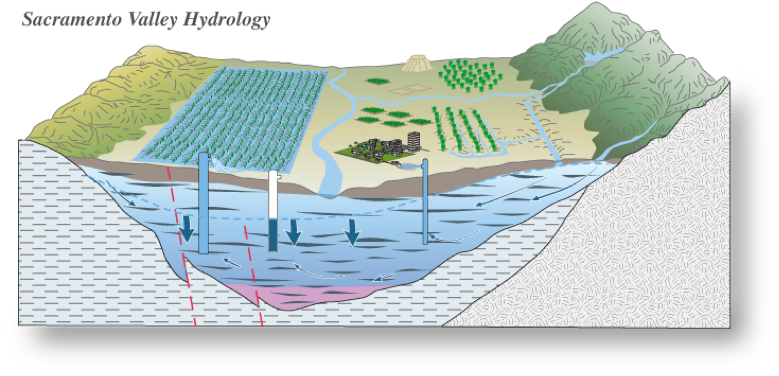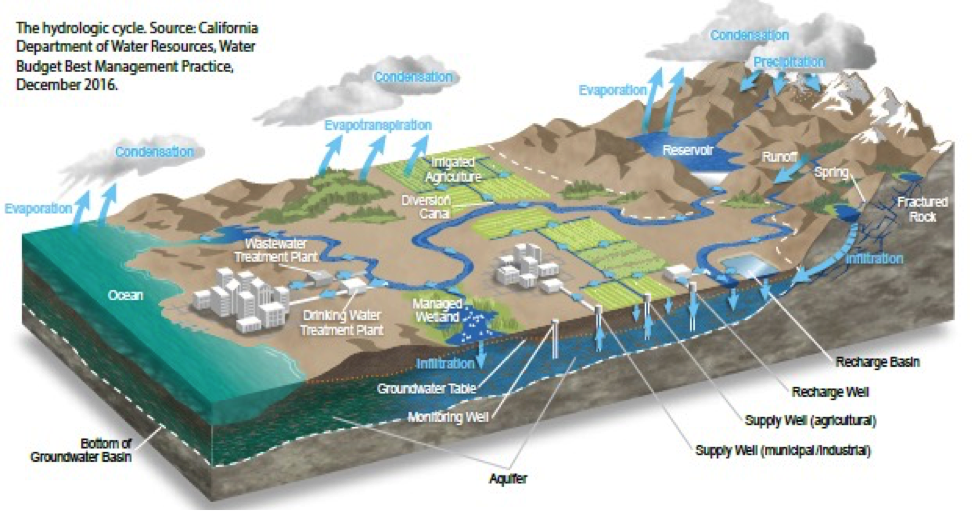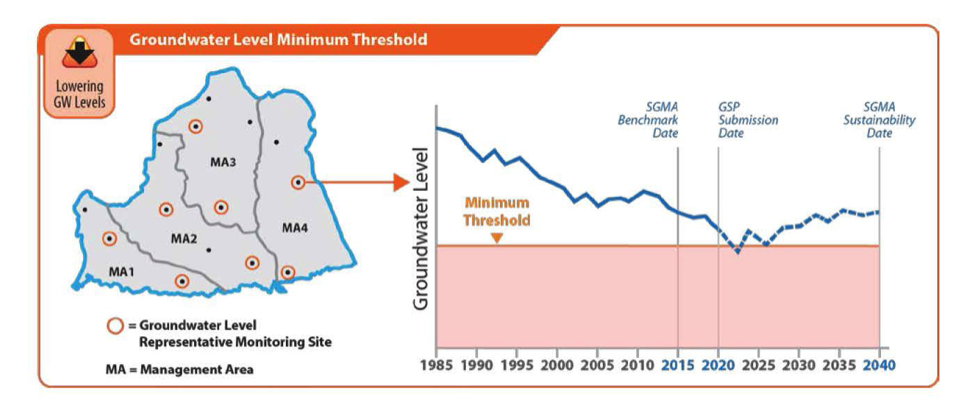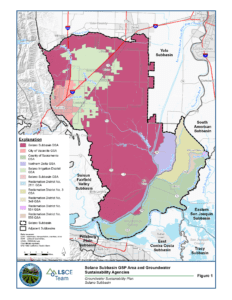Definitions
Basin Prioritization is the classification of groundwater basins based on a variety of factors identified in statute, such as population and the number of water wells in a basin (see Water Code § 10933). DWR was first directed to prioritize basins as part of the Groundwater Monitoring legislation adopted in 2009, which established the order in which DWR would evaluate basins to determine whether monitoring provided sufficient information to demonstrate seasonal and long‐term trends in groundwater elevations, as required by that law. DWR created the California Statewide Groundwater Elevation Monitoring (CASGEM) Program in response to the Groundwater Monitoring legislation, and released the CASGEM prioritization of basins in 2014. The Sustainable Groundwater Management Act (SGMA), which became effective in 2015, required DWR to prioritize basins for purposes of SGMA shortly after the law took effect (see Water Code § 10722.4). DWR implemented the 2014 CASGEM Basin Prioritization as the initial SGMA Basin Prioritization in 2015.
Basin means a groundwater basin or subbasin identified and defined in Bulletin 118 or as modified pursuant to Chapter 3 (commencing with §10722).
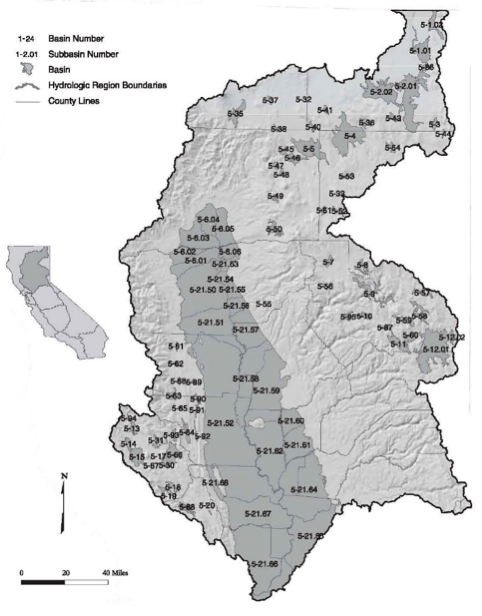
Source: California Department of Water Resources Bulletin 118
Basin Boundary Modification or “BBM” means a change to the boundary of a basin or subbasin. The Sustainable Groundwater Management Act (SGMA) established a process for local agencies to ask the Department of Water Resources (DWR) to revise the boundaries of existing groundwater basins or subbasins, including establishing new subbasins.
Basin Setting means the information about the physical setting, characteristics, and current conditions of the basin as described by the Agency in the hydrogeologic conceptual model, the groundwater conditions, and the water budget, pursuant to Subarticle 2 of Article 5.
Best Available Science means the use of sufficient and credible information and data, specific to the decision being made and the time frame available for making that decision, that is consistent with scientific and engineering professional standards of practice.
Best Management Practice means a practice, or combination of practices, that are designed to achieve sustainable groundwater management and have been determined to be technologically and economically effective, practicable, and based on best available science.
Bulletin 118 means the DWR report entitled “California’s Groundwater: Bulletin 118” updated in 2003, as it may be subsequently updated or revised in accordance with §12924.
Coordination Agreement means a legal agreement adopted between two or more groundwater sustainability agencies intending to develop and implement multiple Plans to ensure that the Plans are developed and implemented utilizing the same data and methodologies, and that elements of the Plans necessary to achieve the sustainability goal for the basin are based upon consistent interpretations of the basin setting.
Data Gap means a lack of information that significantly affects the understanding of the basin setting or evaluation of the efficacy of Plan implementation, and could limit the ability to assess whether a basin is being sustainably managed.
De Minimis Extractor means a person who extracts, for domestic purposes, two acre-feet or less per year.
Governing Body means the legislative body of a Groundwater Sustainability Agency (GSA).
Groundwater means water beneath the surface of the earth within the zone below the water table in which the soil is completely saturated with water, but does not include water that flows in known and definite channels.
Source: https://pubs.usgs.gov/fs/2009/3057/images/sacramento_valley_diagram.png
Groundwater Recharge or “Recharge” means the augmentation of groundwater, by natural or artificial means.
Source: California Department of Water Resources
Groundwater Sustainability Agency or “GSA” means one or more local agencies that implement the provisions of this part. For purposes of imposing fees pursuant to Chapter 8 (commencing with Section 10730) or taking action to enforce a groundwater sustainability plan, “groundwater sustainability agency” also means each local agency comprising the Groundwater Sustainability Agency if the plan authorizes separate agency action.
Groundwater Sustainability Plan or “GSP” means a plan of a groundwater sustainability agency proposed or adopted pursuant to this part.
Interconnected Surface Water means surface water that is hydraulically connected at any point by a continuous saturated zone to the underlying aquifer and the overlying surface water is not completely depleted.
Source: E-Education
Local Agency means a local public agency that has water supply, water management, or land use responsibilities within a groundwater basin.
Management Area means an area within the subbasin where the GSP may identify different minimum thresholds, measurable objectives, monitoring, or projects or management actions, based on differences in water use sector, water source type, geology, aquifer characteristics, or other factors.
Source: California Department of Water Resources
Measurable Objective means a specific, quantifiable goal for the maintenance or improvement of specified groundwater conditions that have been included in an adopted Plan to achieve the sustainability goal for the basin.
Minimum Threshold means a numeric value for each sustainability indicator used to define undesirable results.
Plan means a Groundwater Sustainability Plan or GSP as defined in the Act.
Planning and Implementation Horizon means a 50-year time period over which a groundwater sustainability agency determines that plans and measures will be implemented in a basin to ensure that the basin is operated within its sustainable yield.
Recharge Area means the area that supplies water to an aquifer in a groundwater basin.
Sustainability Goal means the existence and implementation of one or more groundwater sustainability plans that achieve sustainable groundwater management by identifying and causing the implementation of measures targeted to ensure that the applicable basin is operated within its sustainable yield.
Sustainable Yield means the maximum quantity of water, calculated over a base period representative of long-term conditions in the basin and including any temporary surplus that can be withdrawn annually from a groundwater supply without causing an undesirable result.
Undesirable Result means one or more of the following effects caused by groundwater conditions occurring throughout the basin:
(1) Chronic lowering of groundwater levels indicating a significant and unreasonable depletion of supply if continued over the planning and implementation horizon. Overdraft during a period of drought is not sufficient to establish a chronic lowering of groundwater levels if extractions and groundwater recharge are managed as necessary to ensure that reductions in groundwater levels or storage during a period of drought are offset by increases in groundwater levels or storage during other periods.
(2) Significant and unreasonable reduction of groundwater storage.
(3) Significant and unreasonable seawater intrusion.
(4) Significant and unreasonable degraded water quality, including the migration of contaminant plumes that impair water supplies.
(5) Significant and unreasonable land subsidence that substantially interferes with surface land uses.
(6) Depletions of interconnected surface water that have significant and unreasonable adverse impacts on beneficial uses of the surface water.
Water budget means an accounting of the total groundwater and surface water entering and leaving a basin including the changes in the amount of water stored.
Source: California Department of Water Resources
Water Use Sector means categories of water demand based on the general land uses to which the water is applied, including urban, industrial, agricultural, managed wetlands, managed recharge, and native vegetation.
Subscribe to Solano Subbasin Newsletter
Clicking on the link above will take you to an interactive Solano Subbasin and GSA Boundaries map.
Contact
Solano Groundwater Sustainability Agency
810 Vaca Valley Parkway, Vacaville, CA 95688
Tel: 707.451.6090 Fax: 707.451.6099

